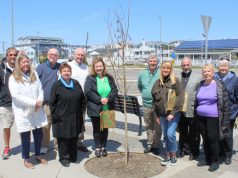
By BOB THIBAULT
This is how Landis Avenue in Sea Isle City looked nearly a century ago. Visitors were greeted by the sight of two spires – that of the Methodist church on the left and that of the Catholic church on the right.
It hadn’t always been that way, and it certainly isn’t that way today.
Sea Isle became an official Borough in 1882. Within two years, both Methodist and Catholic churches had been built, but not on Landis Avenue.
Both denominations had started as church-less congregations, built a church, dedicated it in the same month (July 1884), moved that church to a new location, raised it one level, and then settled in for many years at the new site until a larger, more modern facility was constructed. The parallel of progression was almost uncanny.
This is the story of those early churches, how and where they came to be. The buildings didn’t spring up miraculously to accommodate the faithful. It was hard work.

The Methodist Church
In the beginning, an informal gathering of Methodists, Presbyterians and Baptists would meet for services at the John Teleford home on 39th Street. But by the spring of 1883 it became clear that more space was needed. They needed a church.
The Telefords were Presbyterians, but the largest contingent at these meetings was Methodist. So democracy ruled, and the new church was to be incorporated under Methodist auspices.
Charles K. Landis, Sea Isle’s founder, donated two lots (worth $600) on 40th Street for the new church. On September 13, 1883, the cornerstone was laid. And by the fall of that year, the entire project was nearly paid off. The official dedication took place on Sunday, July 27, 1884. Sea Isle had its first Methodist Episcopal Church.
Three years later, in 1887, the building was raised to add a social hall beneath and a heating system was installed. Apparently, the congregation had been subjected to sacrificial shivering during the previous three winters.
But that wasn’t their only hardship. Cometh the trains.
The first trains began bringing visitors to Sea Isle in 1882. And they kept coming. By 1893, both the Pennsylvania and the Reading Railroads carried thousands of tourists each year to the city, mostly right past the site of the Methodist Episcopal Church. This was very annoying.
It got so annoying that the congregation decided they had to move. This was, as the literature calmly states, “because of the loud noise of the trains.”
That was putting it politely. It must have seemed as if the devil himself was dragging those rattling, screeching, belching hunks of steel right through the middle of the church sanctuary.
So, in 1905, they finally moved.
It must have been quite a sight. Somehow, the entire structure was packed up and trundled a half-dozen blocks to its new home at the southeast corner of 45th Street and Landis Avenue.
In 1911, a new parsonage was built at a cost of $2,560, plumbing included. And there the church thrived for the next 47 years.
When the church building was demolished in 1981, its 331-pound brass bell was preserved and is currently nestled in the tower of the condominium building at that same location.

By 1956, a new, larger church was needed. Eight lots were purchased on JFK Boulevard between Park Road and Central Avenue and a more modern and spacious building was completed in 1958.
A parsonage was added three years later, and a steeple in 1963. The United Methodist Church still stands today, more than a half a century later.
The Catholic Church
The history of Catholicism in Sea Isle really began as soon as Charles Landis brought the first visitors to town in 1881. A missionary priest, Father Gessner, would travel hundreds of miles throughout South Jersey to serve Catholics wherever they gathered.
Another priest, Father Charles Geise, pastor of the Millville Church, would say Mass in nearby Ocean View. So there were venues available to the very early Catholic population of Sea Isle, if they could get to them.
Later, when the city began to grow and visitors began to come in large numbers, Mass was held in private residences such as the Maiswinkle home at 43rd Street and the Dever home on 45th Street. Again, as with the Methodists, it was apparent that a dedicated church was needed.
On August 13, 1883, Charles Landis sold four lots to the Bishop of Trenton “for the purpose of erecting … buildings connected with the Roman Catholic Church.” The cost was a bargain at $200. The lots covered the land between 44th and 45th Streets on Central Avenue.
Less than a year later, on May 4, 1884, the cornerstone of Sea Isle’s first Catholic Church was laid and building proceeded at a pace that would make today’s contractors’ heads spin. The total cost for the project was calculated to have been $4,343.45. Pews were rented to parishioners at ten dollars a year to help pay it off.
The formal dedication of the church to Saint Joseph took place on July 20, 1884 – coincidentally, the same month that the Methodist Episcopal Church held its dedication.
The new Saint Joseph Church faced 44th Street, the main horse-and-buggy artery into town. It was a welcome sight to visitors at the end of their bumpy trip across the meadow – just after they had passed the somewhat less welcoming city jail.

By the turn of the century, Saint Joseph had been made an official parish of the Diocese of Trenton, a new rectory had been built, and all mortgages had been paid off.
Then in 1903, a lot was purchased from Charles Landis and the church was carted over to the northwest corner of 44th Street and Landis Avenue where the building stands today.
The church was raised to provide for a hall underneath. It was also lengthened and a street level entry added to the front. Parishioners were required to maneuver up narrow winding staircases inside the building to reach the church proper.
In 1939, the front entrance to the church was totally rebuilt, which gave it a medieval Gothic look. As a practical matter, outside steps were added to eliminate those winding stairways. The building got a new front wall with buttresses and double rounded arch doorways. Leaded glass windows were installed, including a 7½-foot circular “rose” window depicting St. Joseph holding a lily.
Later in the year, a lighted statue of Saint Joseph was added in a niche above the doors. The light was timed to turn off at midnight, so local teenagers knew they had to be home before St. Joseph “went out.” All this and more, for a total cost of $7,700.
Although Mass is no longer celebrated there, the building has remained much the same to this day. A new, much larger and more modern Saint Joseph Church was built next door and dedicated on December 18, 2011. This is where services are conducted today.

This “Spotlight on History” was written by Sea Isle City Historical Museum volunteer Bob Thibault.
A “thank you” is extended to Harriett Reardon Bailey and to Mike McHale for reviewing a draft of this article.
Unless otherwise noted, photos were provided courtesy of the Sea Isle City Historical Museum.
To enjoy a collection of photos, literature and artifacts, please visit the Sea Isle City Historical Museum at 48th Street and Central Avenue. Access the website at www.seaislemuseum.com or call 609-263-2992.
Current museum hours are 10 a.m. to 3 p.m. on Monday, Tuesday and Thursday, and 1 p.m. to 3 p.m. on Friday. Admission is free.







